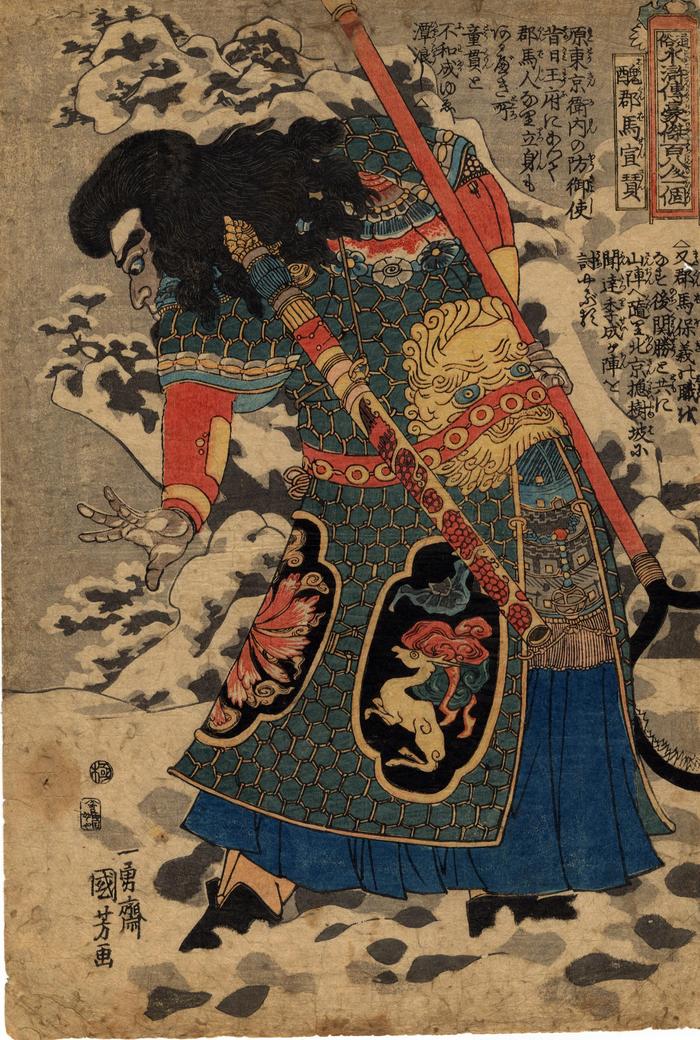Utagawa Kuniyoshi (歌川国芳) (artist 11/15/1797 – 03/05/1861)
Xuān Zān (Ch. 宣贊), the Ugly Son-in-Law (Shūgunba Sensan - 醜郡馬宣贊) from the series One Hundred and Eight Heroes of the Popular Shuihuzhuan (Tsūzoku Suikoden gōketsu hyakuhachinin no hitori - 通俗水滸傳濠傑百八人一個)
1827 – 1830
10 in x 14.75 in (Overall dimensions) color woodblock print
Signed: Ichiyūsai Kuniyoshi ga
一勇斎国芳画
Publisher: Kagaya Kichiemon
(Marks 195 - seal 22-025)
Censor's seal: kiwame
British Museum
Tokyo National Museum
Ishikawa Prefectural Museum of Art
Nationaal Museum van Wereldculturen (Rijksmuseum Volkenkunde, Leiden) via Ritsumeikan University
Lyon Collection - another copy of this print Shūgunba Sensan, #44 in Klompmakers' book, is armored, but bare-headed in the snow, carrying a pole with a large, barbed ring at the end of it.
Sensan, like many of the figures in the Suikoden, starts out as an imperial commander sent against the gang of bandits. However, he is defeated by a female warrior and he then changes sides.
In a plot to rescue two captured members of the gang Sensan takes part in an attack on Beijing during the Festival of the Lanterns. In this print Sensan is shown standing in wait in the snow outside the city waiting to capture or destroy fleeing enemies.
If you look closely you will see three propitious symbols in the panel decorating the bottom of Sensan's protective armor: a blue bat, a kylin (麒麟) and a ju-i (如意) fungus which appears to be walking.
We do not know who designed the elaborate clothing of this figure. Was it Kuniyoshi himself? We want to believe so, but won't know for sure unless we can find one of those rare items, the preparatory sketch. In other cases we do know that an artist would give over a bare-bones, linear drawing to the publisher who would have the master carver fill in the robe design himself, with or without consultation with the artist. We mention these points because of one of the interesting motifs to be found on Xuan Zan's clothing: a tied-cord motif that mimics the tortoiseshell motif referred to as kikkō, a pattern often warn by warriors. However, we have never seen one quite like this one where the motif itself is woven like a piece of macramé.
****
Klompmakers wrote: "Shūgunba Sensan commands both the infantry and cavalry of the imperial forces. His face is jet black; he has a turned-up nose and a red beard. In chapter 62 the emperor dispatches Sensan, along with Dairō Kanshō... and Seibokukan Kakushibun, to overthrow the Ryōsanpaku gang. Unsuccessful, Sensan is then captured by the female warrior Boyasha Sennijō... in chapter 63. Hereafter this commander of the imperial troops decides to become a leader in the Ryōsanpaku band as they make preparations to liberate Gyokukin Roshbungi... and Henmeisarō Seikishū... This rescue mission takes place during the annual Feast of lanterns [sic?] in Peking. After Roshungi and Sekishū's release, the brigands reduce a great portion of Peking to ashes."
"This print shows Sensan watching the snowy surroundings of Peking during the feast. Poised with his barbed ring on apole, he is probably waiting to catch fleeing enemy soldiers. Robinson believes that Sensan and Boyasha Sonnijō are part of a pentaptych including the images of Tenmokushō Hōki, Kyūsenpō Sakuchō and Seibokukan Kakushibun... (...respectively). The backgrounds of the Sensan and Sennijō prints, however, do not match the other prints which together clearly form a triptych. Suzuki maintains that the prints of Sensan and Sonnijō are a diptych, but the same argument, i.e., the mismatching backgrounds, can also be used to refute this. Furthermore, the design of Sennijō is such a solitary composition that it is difficult to conceive of it as part of a larger composition. As a diptych, the images of Sensan and Sennijō would differ considerably from other such examples in this series, which we are characterised by balanced and rather symmetrical compositions."
Quoted from Of Brigands and Bravery: Kuniyoshi's Heroes of the Suikoden by Inge Klompmakers, page 144.
****
The text reads: 原東京右衛内の防御使 昔日王府にあつて郡馬人なり 立身もあるべき所童貫と不和成ゆゑ漂浪し又郡馬保義の職をなす 後関勝と共に山陣へ随り 北京槐樹坡に聞達季成が陣を討やぶる
****
Illustrated in a full-page in a color reproduction in Of Brigands and Bravery: Kuniyoshi's Heroes of the Suikoden by Inge Klompmakers, Hotei Publishing, 1998, #44, page 145.
Kagaya Kichiemon (加賀屋吉右衛門) (publisher)
warrior prints (musha-e - 武者絵) (genre)
Suikoden (水滸傳) (genre)
bats (komori - 蝙蝠) (genre)
